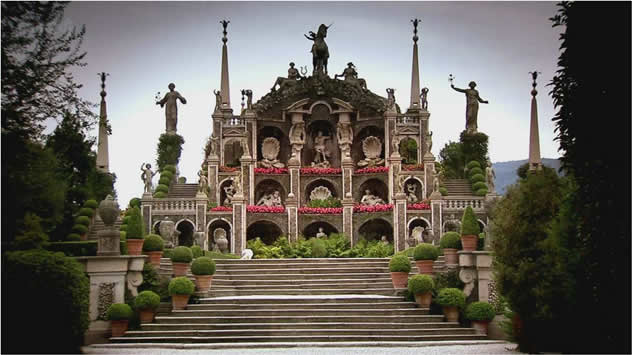Student: And that was the purpose?
學(xué)生:那就是全部目的了嗎?
To impress people?
打動人們?
Professor: Sure. As a nobleman or wealthy landowner, one purpose of having a fabulous villa with a fantastic garden was to impress people.
教授:當(dāng)然。作為一個貴族或富有的地主,擁有極佳的別墅,還附有極美的花園,其中一個目的就是為了給人們留下深刻印象。
It was a way of proving your social position.
這是證明社會地位的一種方式。
Student: Well...OK.
學(xué)生:好吧。
You also mentioned tricks.
你提到了花招。
Professor: Well, for example, some gardens had plaster or marble birds that sang when water flowed through them.
教授:舉個例子,一些花園里有石膏或大理石做的鳥,在水流過時會唱歌。

Some fountains were designed to squirt people with water.
有的噴泉被設(shè)計成向人們噴水。
Student: And these things were popular?
學(xué)生:這些東西都很流行?
Professor: Yes. They may have been the most popular features of the gardens.
教授:對。這些很可能是花園中最常見的特征了。
I mean, flowers and statues can be nice to look at, but these things were a lot more fun.
我是說,花朵和雕像當(dāng)然給人以視覺享受,但這些東西有趣多了。
And the more clever the device is, the more famous the garden and the greater prestige the landowner enjoyed.
而且裝置越巧妙,花園就越著名,地主也就享有更多聲望。
Yes? Rebecca.
麗貝卡。
Student: What about mazes?
學(xué)生:那迷宮呢?
I read that they were a major part of the Renaissance gardens.
我看到過,迷宮是文藝復(fù)興時期花園的主要部分。
Professor: Oh, yes.
教授:對。
They certainly were!
它們當(dāng)然是!
Mazes or labyrinths, as they're also called, were very common in Renaissance gardens.
迷宮(他們是這么叫的)在文藝復(fù)興時期的花園里非常常見。
How that came to be though is a bit of a mystery.
到底是怎么發(fā)展而來的,還是個謎。
Mazes have a long history going back to the ancient Egyptians, but they started appearing in gardens only during the Renaissance, or perhaps just a little bit prior to that.
迷宮的歷史非常悠久,追溯到古埃及時期,但迷宮只在文藝復(fù)興時期出現(xiàn)在花園里,或可能稍微早些。
According to one source, what happened was: in the late 1400s, a highly respected expert published a book on architecture.
根據(jù)某信息來源,發(fā)生的事情如下:在15世紀(jì)晚期,一位備受尊敬的專家出版了一本建筑方面的書。
And readers somehow mistakenly inferred from that book that ancient Romans had mazes in their gardens.
不知怎么的,讀者從書中誤得出古羅馬人的花園里有迷宮的結(jié)論。
So then designers of Renaissance gardens thinking they were following in the footsteps of the ancient Romans...well...guess what they did.
接著,文藝復(fù)興時期的花園設(shè)計師們以為他們跟隨了古羅馬人的腳步......猜猜他們到底做的是什么?
What does the professor mainly discuss?
教授主要講了什么?
The professor mentions three authors from ancient Roman, what point does the professor make about the three authors?
教授提到了古羅馬的三位作者,對于這三位作者,他表達(dá)什么觀點?
Why does the professor mention Hero of Alexandria?
為什么教授提起亞歷山大港的希羅?
According to the professor, what was one goal of the designers of Renaissance gardens?
根據(jù)教授所言,文藝復(fù)興時期花園設(shè)計師的一大目標(biāo)是什么?
What does the professor imply about mazes?
關(guān)于迷宮,教授暗示了什么?
Listen again to part of the lecture, then answer the question.
再聽一遍部分課程,回答問題。
As we've said before, the main point of the Renaissance was to revive the genius of the ancient Greeks and Romans, which is why designers of Renaissance gardens designed them as the ancient Romans would have designed them, or at least as they imagined the ancient Romans would have designed them.
正如我們之前所說,文藝復(fù)興主要是為了讓古希臘和古羅馬的輝煌藝術(shù)重現(xiàn)光彩,這就是為什么文藝復(fù)興時期的花園設(shè)計師將花園設(shè)計成古羅馬人會設(shè)計成的樣子,或至少是他們想象中古羅馬人會這么設(shè)計。
What does the professor imply when he said this: which is why designers of Renaissance gardens designed them as the ancient Romans would have designed them, or at least as they imagined the ancient Romans would have designed them.
教授這么說,言外之意是什么?“這就是為什么文藝復(fù)興時期的花園設(shè)計師將花園設(shè)計成古羅馬人會設(shè)計成的樣子,或至少是他們想象中古羅馬人會這么設(shè)計。”










